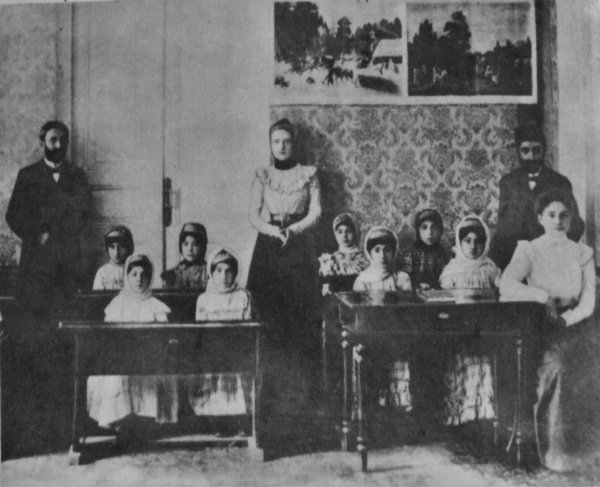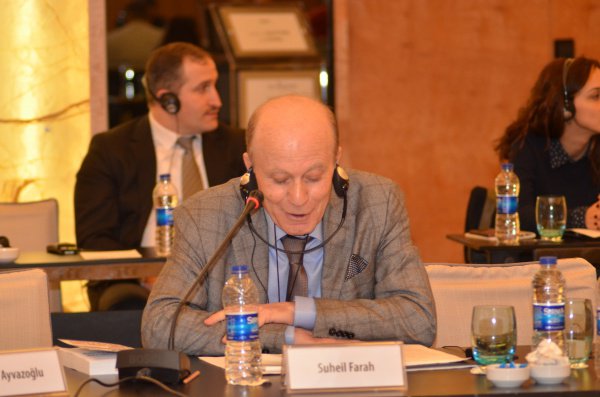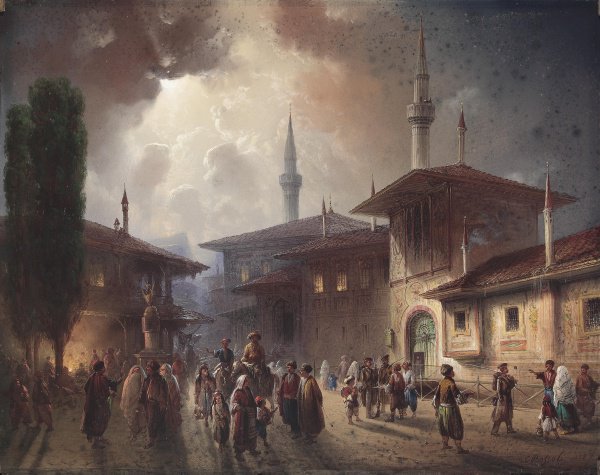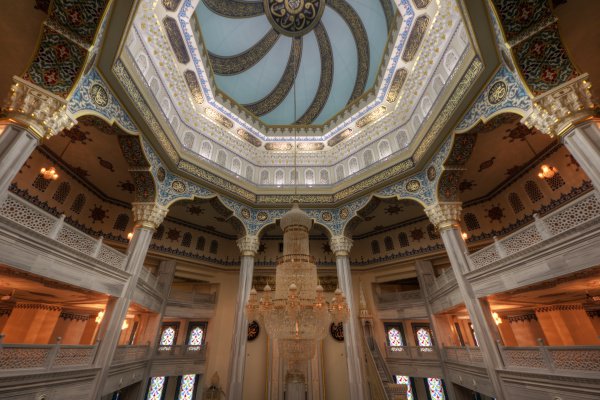As mentioned in the section dealing with the ethnic composition of Russia, there are large and small groups that form the general ethnic fabric of Russia. Among these groups there are two main ethnic groups, each associated with the religious doctrine level.
The Slavic ethnic group, which constitutes the majority, has embraced the Orthodox majority. Turks are considered the second-largest ethnic group most of its believers are Sunni. Compared with most Western European countries, Russia has its own relationship with the peoples of the Islamic East. It is not only geographically closer to it, but it is more aware of its mentality because of its geopolitical and socio-cultural and religious peculiarity, where European interacts with Asian, Western with Eastern-Christian with Muslim. As one Russian thinker (Rubetsky N. S.) points out "The Eastern Slavs, who were able to extend via all the Russian steppes, had a relationship of communication and interaction with their neighbors in the south and east through the mixing of life, in all spheres of life, between the Slavic group and the Turkish group, as the red thread was woven of the entire Russian history" [Rubetsky N. S., Russia Between Asia and Europe, Moscow, 1999, p 5].
Indeed, the great role of the Slavic group at the level of the historical face of Russian culture and the role of Orthodoxy, as the primary religious and spiritual incubator of this culture, should not be seen in "the Slavonic-Orthodox View" of Russian history. Objective researchers often collide with this vision, which refrains them from giving the natural size of the Turkish and Asian Islamic group, which contributed significantly to the formation of the general cultural fabric of Russian society.
There are many data, facts and figures that confirm at various historical stages the remarkable role of this group in more than one sensitive area; it may be important to recall the most important stations. In an interesting edition of Al-Manbar Al-Islami newspaper, published in 1995, the journal of the religious administration of the Muslims of the Central Europe, the newspaper points to the following facts: "The Asian presence at the highest level of Russian rule had a prominent place. Tsar Boris, Fyodor Godunov, and others are of Tatar Muslim origin. Five of the women were wives of five Tsars: Sliema Saburova, first wife of Tsar Vasseli III; Yallina Galskaya the second wife of the same Tsar; and Natalia Nareshkina, third wife of Tsar Alexei Mikhailovich; and Mother of Caesar Peter the Great and Marva Abraskina, wife of Tzar Fyodor Kasiewicz" [Al-Manbar Al-Islami, Moscow, 01/6/1995].

Students and staff of the Erivan Russian-Muslim for Girls. Standing. Sabir Ganjali Mammadov. Women, Beauty and Sanctity. Azerbaijan Publ. Baku, 2001; p. 104
Through various marriages, Muslim blood was also mixed with Christian blood, and this is reflected in multiple manifestations. One of them, one of the holiest shrines of the Russian Orthodox, I mean the first Russian saints Boris and Klepp. In this regard, the famous Russian historian Karamzin points out: "The wife of Prince Vladimir, whose ruling era witnessed that Russia had become Christian, was a Muslim Bulgar and she was the mother of Princes Boris and Klepp, who were predestined by the Russian Orthodox Church as their first saints" [Karamzin, History of the Russian State, Moscow, 1983 p 87.].
There is a lot of talk among Russian historians about the era of the Tatar-Russian invasion, some of which see the darkest and gloomiest stage in Russian history, the stage that brought the idea of Asian tyranny, and deeply affected the political mind of the ruler. And others see it as a kind of interaction that was not in its final outcome mixed with negativity. This idea will be dealt with in some detail in various places of this research. The important issue, which we would like to remark, is that the genetic program of the Russian nation has been supplemented by amendments and results that have had an impact on the ethnic and physiological composition of a large number of Russians.
In modern and contemporary history, many millions of mixed marriages have led to the formation of generations that are neither purely Slavic, nor Tatar, Mongolian, Finnish or Semitic –purely Jewish or Turkish.
However, the historical fact of ethnography, religion and culture of these two major groups has led to the pattern of thinking and life of many Russian urban and rural populations, which made Russia before the arrival of Tsar Peter the Great, closer to the civilized lifestyle of Eastern societies.
However, the revival of the Slavic-Orthodox element two centuries earlier and the growing interest in the Western European style of civilization, made Russian civilization far away from the eastern side of its character. The beginning was evident during the reign of Tsar Peter the Great in the early 18th century, as He tried to breathe in the Russian spirit a kind of rationalization and secularization and make it closer to enter the space of European modernization. However the Russian-Muslim peoples of Turkish and Tatar origin were not immune to these historical transformations.
The minds of many of its sons have been swept away by the winds of modernity, and a class of intelligentsia has brought the values of modernity. Perhaps the most important role played by the Russian educational institutions, and the increasing Russian interest in the Tsarist and Soviet period, more broadly in world cultures, was the most important reason for helping these peoples to open up their cultural horizons to a wider and broader field, which was the general outcome of the transfer of Russian mentality to a distant stage towards «Europe» and thus secularization. Another trend, however, is the remarkable nostalgia for its ethnic and religious origins, particularly the Islamic ones.
His social and cultural imagination, at the tsarist and soviet stage, took every historical opportunity to express himself and tries to highlight his peculiarity by enhancing the role of this factor or that in its own right. As a result of the rise of the religious factor in recent years in the world, Islam in the Turkish-Tatar and Asian groups has replaced all other factors of cultural and civilizational self.
After many centuries, it has been marginalized, and after a certain period of time, seems to have become a remnant of history, it has emerged in the last ten years to form a status or a phenomenon, its presence began to exceed the Turkish, Tatar and Asian-Russian influences, affecting certain aspects of Russian religious, cultural, political and economic life. In the current stage, the Russian Islamic group is dynamic in most areas, making it one of the most prominent groups whose movement is growing horizontally splintered and vertical in the Russian body.
Let us leave aside some figures, facts and data to express themselves in the post-Soviet era: until 1999, the number of mosques in Russia reached about 4,000. As of 1998, 2,734 Islamic associations and 106 religious education schools with high institutes of Islamic education had taken note and expertise from the Russian Ministry of Justice [See Versions 1 and 3 of Islam in the Contemporary World, Nagne-Novgorod, 2005].
The number of Muslims has not yet been accurately known. Among a figure of up to 30 million that is repeated by some Russian Muslims and repeated in speeches by one of the most prominent radical Islamic leaders of Russia, Haider Jalalov, but a limited number promoted by some sociological institutions of the official circles and settle at the limit of 12 million. There is a realistic figure, which is estimated by the central administration of Russian Muslims between 17 and 18 million Muslims in the Russian Federation among about 148 million people.

Dr. Soheil Farah
If we exclude the Russian atheists, and their number is not simple and the supporters of non-traditional religions, Islam comes second only to Orthodoxy, and may be distinguished by its dynamism and continuity in the practice of religious rites. The political landscape of this group is not less dynamic than its religious scene. There are associations in which religious and political overlaps, which are not few, also there are associations and political parties dominated by political activity, most notably the following parties:
Nur, the Federation of Russian Muslims and the Islamic Dawa Party, the first two parties actually reflect the political mood of most Russian Muslims and maintain close rapprochement with all the parties, religions and ethnic groups active on Russian soil. They are in constant contact with the Orthodox Church and the ruling regime.
The question is: What about the future of Islam in Russia? The state of Islamic religious revival in Russian society appears in more than one field at the level of culture and faith, and the phenomenon of religious revival for Russian Muslims has many causes. The majority of Muslims belong to the Tatar, Bashkir, Dagestan and Chechen peoples, and other small populations. Some concerns and fears apply within them, partly because they are melting on some aspect of the Russian westernized cultural sphere, and some religious and political elites, did not find to maintain their privacy stronger than Islam. Their obsession is not only the melting of the Slavic-Orthodox present, but also the dangers of the leak of Westernized global values sweeping large segments of Muslim people, especially the young generations.
The danger in these elites is not only seen in the values of material and political globalization but also in the spread of Western Christian doctrines such as Protestantism and evangelism. In fact, Russian consciousness as a whole is in a state of great tension after the rapid and surprising knowledgeable and ideological rupture with the ideology of the Soviet era. It is no longer confined to one ideology, one economic choice or one party. The intellectual, emotional and spiritual affiliation of Muslims, Orthodox, Buddhists, and others has become fragmented.
At the Islamic level, membership is divided into four main streams:
First, a stream, in which religion and ethnicity overlap and are in some way close to, or intersect with the general Eurasian belonging of the Russian Federation, second, which is determined by the desire to re-establish a "neo-Soviet", third, by-which the Islamic culture that finds itself in harmony with the new patterns of thinking and behavior of Western globalization, fourth, a radical Islam influenced by the radicalization of some groups of Arab and international political Islamism.

The Crimean Khan's Palace in Bakhchysarai in 1857. Crimea was conquered by the Russian Empire in 1783
Talking about a general Islamic political phenomenon in the Russian Federation State, or more precisely in the Russian Federation, is also a hypothesis that still needs a certain stage of time to be recognized or excluded. However, the Islamic parties or the general Islamic mood has become a force, or a significant moral figure between the Tatars, Chechens, Ingushetia, Bashkir and other Muslims spread over Moscow, Volga basin and Siberia. And to say (there is one monolithic Islamic group) has no factual data. There is a distribution, but a contradiction and sometimes dispute on the quadrant of money, power, authority and religious knowledge, and this may be due to several causes and circumstances, most notably as follows:
First, the geographic distance and numerical disparity between this region and that, puts its objective obstacles to the unremitting effort of the Federation of Russian Muslims.
Second, the ethnic differences and conflicts of interest and objectives toward the attitude of the central state policy, not only to the complex Chechen issue, but also to separatist tendencies in Tatarstan and others, made the Islamic voice not only dominated by pluralism, but sometimes paradoxically till dispute.
Third: the struggle of the Islamic religious elites over the references, and on many religious and secular issues, is what caused a schism that appeared to be apparent.
One part represented by the head of the spiritual administration of the Muslims of the European-Russian section Imam (Raoul Ain Din), and another represented by the official representative of the Muslims of Russia in the organizations of the "Organization of Islamic Conference" and UNESCO and the Association of European Muslims, Imam (Talat Taj Eddin). And also a third was distributed to heads of religious administrations in mostly Muslim-dominated republics, and a fourth radical populist, rebel against the three branches of the Russian Islamic authorities, was created.
Fourth, the differences that have begun to be seen between the base of the Islamic parties and their leaders on many issues, one of them is the challenge of separation from and integration into the central Russian state. And with each option or challenge its parties and its supporters to the official Islamic Russian institution. Despite the presence of the majority of Muslims outside Moscow, however the Maestro who drives the threads of the Russian Islamic movements the capital itself and not the other parties.
And there are many attempts and unilateralist movements started, and still seeks to unify the word of Muslims, by choosing one head for them, as happened in 1996, when was for a period not exceeding six months, the choice of moderate Russian Muslim figure Ramazan Abdul Latipov as general coordinator of the Federation of Islamic Organizations of Russia, but this attempt did not succeed.
Despite this diversity and contradiction and conflict; however, the case of Islam began to express itself in the Russian land on more than political, cultural and economic level.
This situation aspires to expand its presence to include the International Islamic Circle through the Organization of Islamic Cooperation or through the establishment of Islamic banks and educational and cultural centers based on their own capabilities at times and also to the support of KSA, UAE, Kuwait, Iran, Turkey and others. All of which aim to support their positions not only in order to assert their specificity, but also to provide realistic data for their continuation and for increasing their influence.

Moscow Cathedral Mosque (new), interior, Wikimedia Commons
At the end of this research, there is no objection to engaging in the adventure of predicting the future of some aspects of the Islamic phenomenon in Russia and put forward the following hypotheses or possibilities:
A- The future of Islam as a religion in Russia is linked to the future of the religious phenomenon as a whole.
B - The crystalization of the political discourse of this Islamic ethnic and religious group may nominate them to play a role in the construction of Russian civil society, in case of success of the democratic development of Russia, and if this group succeeded in the rational unification of its internal forces and sought a far-sighted vision to strengthen the relationship in the form of wise pragmatism with other groups and forces in the Russian capital.
C- The persistence of conflicts between isolationist tendencies, supported by popular bases, internal and external parties, moderate forces and religious and political references, as well as the growth of some radical currents, may weaken the dynamic growth of the Islamic phenomenon and lead to its removal from the political scene.
D- The continued use of the option of violence by the radical line, especially the fundamentalist one, not only fuels the spirit of conflict and dispute within religious groups, but also affects the diverse ethnic composition of Russian society and contributes to the weakening of the entire Russian State.
The course of events in the future is not only due to the nature of the activity of religious and political groups, but also to the cognitive level of the Russian religious phenomenon in general and at the cultural and political level by creating a healthy basis for a peaceful and effective dialogue between religions based on the philosophy and culture of dialogue and cooperation between diverse religious and cultural groups.
Dr. Soheil Farah
